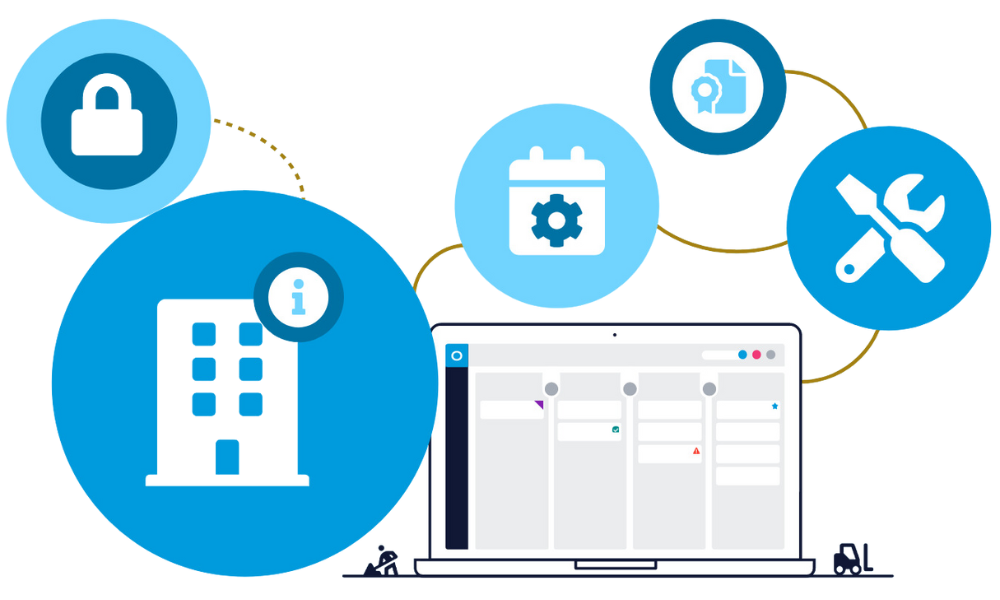
The New Standard in O&M Manuals
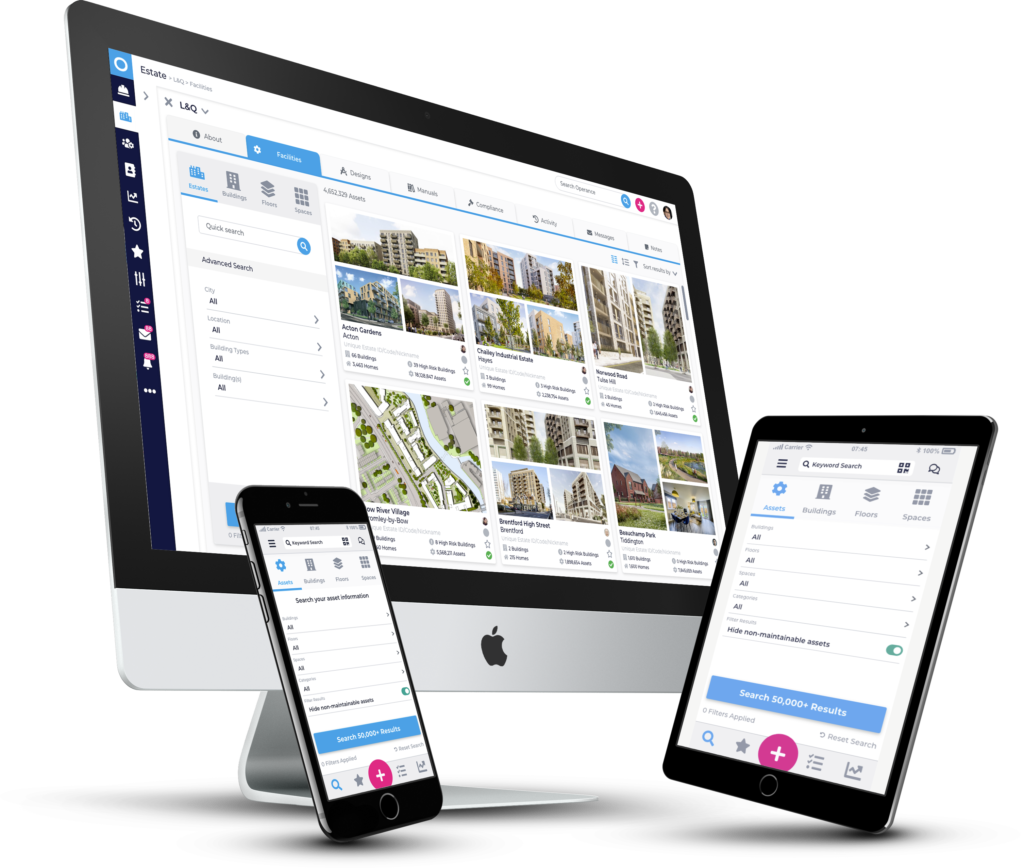
Introducing Building Intelligence
Want to create smarter O&Ms with accurate, quality information? Yep, we’ve got it. But it doesn’t end there. We’ve reimagined what an O&M can do for contractors, owners, operators and occupiers.
Golden Thread & Building Safety Standards
We have developed our software with the key principles of the Building Fire and Safety Acts, and Golden Thread in mind. Scale your business whilst ensuring that health and safety does not get impacted.
Facilities Management
Transform your static information into fully digitised dynamic information that can be kept up to date, with facilities management.
Where Better Information Becomes of Greater Value
Standards Management
Choose sector specific O&M information requirements, or, develop your own client or contractor specific organisational standards to request uniform data across all projects.
Supply Chain Management
Quality Management
Information can be reviewed, accepted or rejected at any point and at stage gateways in line with ISO 19650 standards and building safety legislation.
Information Management
Search, share, edit, supplement and utilise information for facilities management via desktop or mobile beyond handover to maintain the facilities ‘golden thread’.
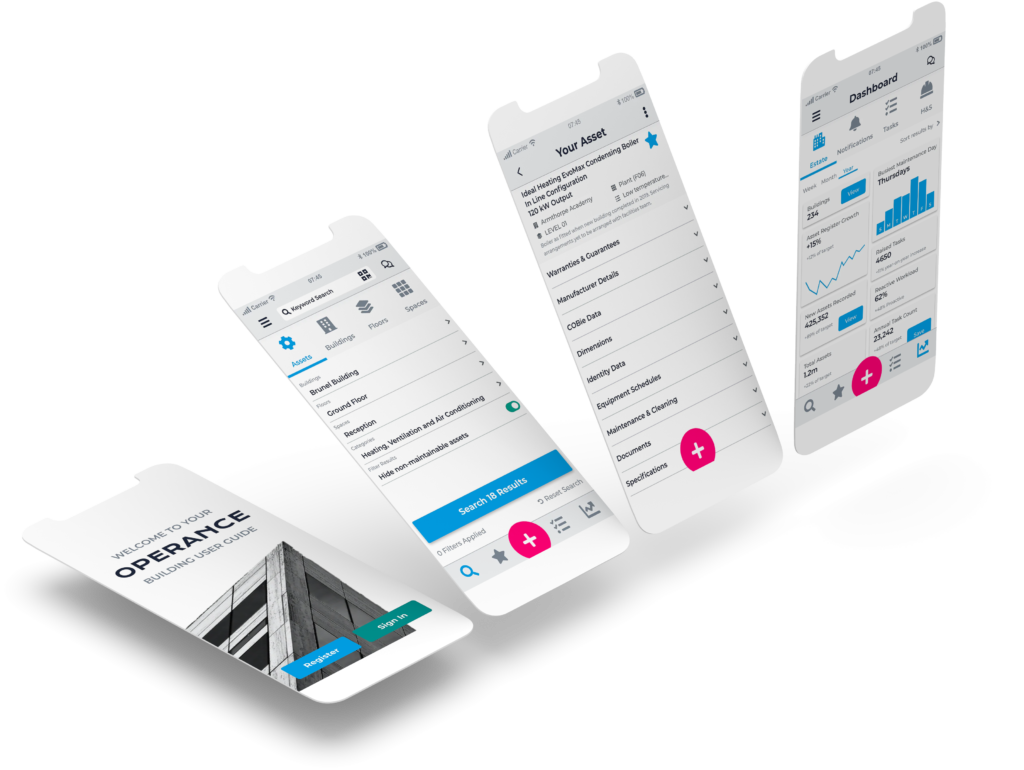
The worlds first smart building manual, making it easy and efficient to operate and maintain your place of home, work and play.
Facilities Management
Manage your facility on the move, keeping ontop of your dynamic information, ensuring that it is kept up to date and inline with your standards.
Supply Chain Database
Maximise your organisation’s proactivity and reactivity, by making the most of our inbuilt supply chain database feature. Search through the database whilst on the move or onsite.
The Single Source of Truth for Your Building Information
To create safer, more efficient environments, you need quality information – standardised, accurate and accessible.
Search
Finally, a simple and lightning-quick
way to find building information.
Update
Edit everything from room naming
to warranty expiry dates and much more.
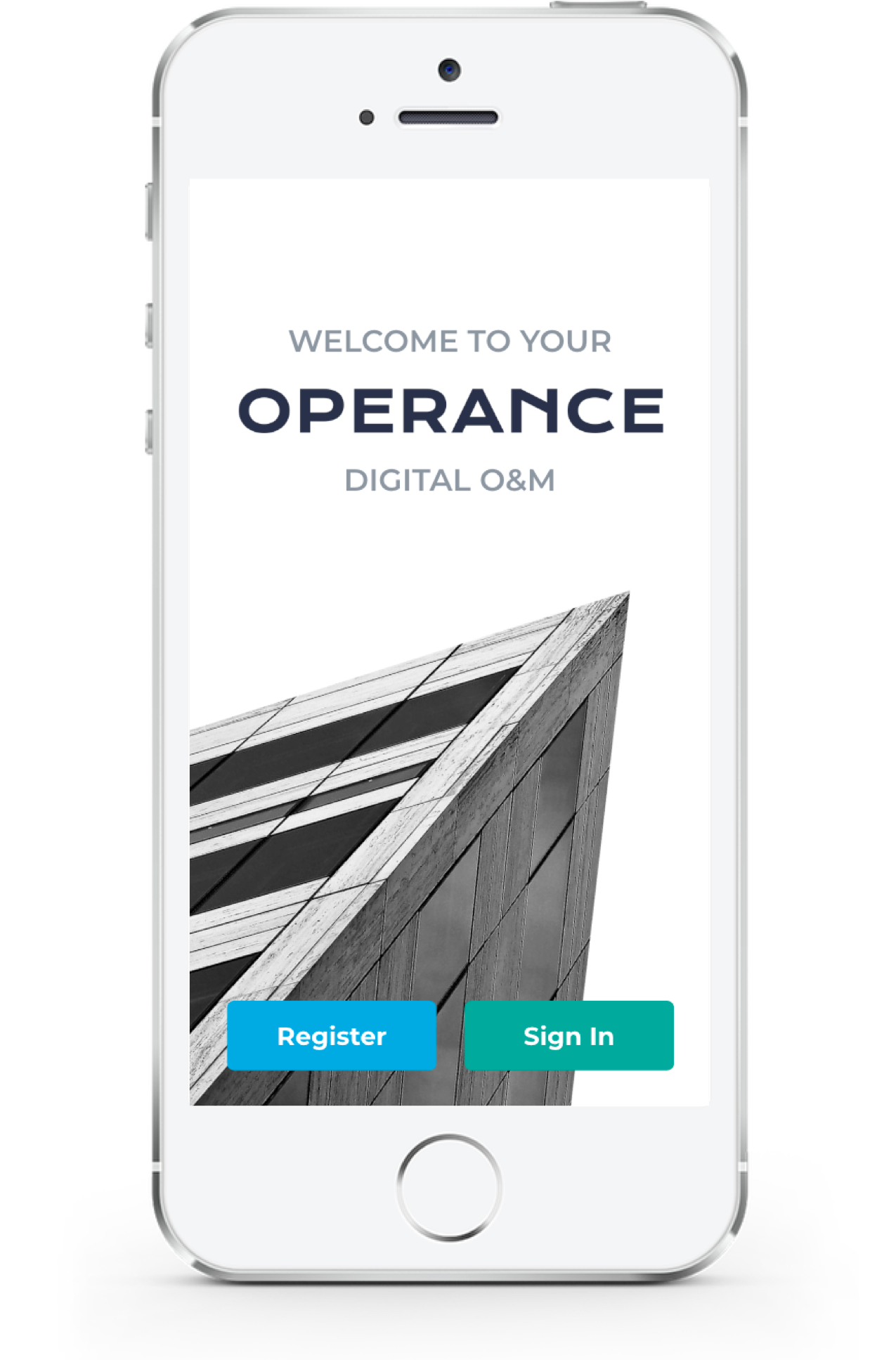
Share
Provide access and send information
to colleagues and suppliers.
Utilise
Use asset information to manage simple
maintenance workflows and compliance alerts.
Got BIM?
If your organisation is utilising the Building Information Modelling (BIM) process to design, build and refurbish facilities, it’s time to achieve a greater long-term return on your investment.
With Operance you can now easily utilise your BIM models and data to power simple task management, compliance alerts and more, all whilst keeping your model up to date and relevant beyond handover.
Operance does this by uploading your model into our app and providing you with simple access to utilise your BIM construction data without needing to invest further in expensive BIM training and 3D visualisation tools. In fact, users need not know anything about BIM what-so-ever! A BIM information manager, giving you asset management at your finger tips …
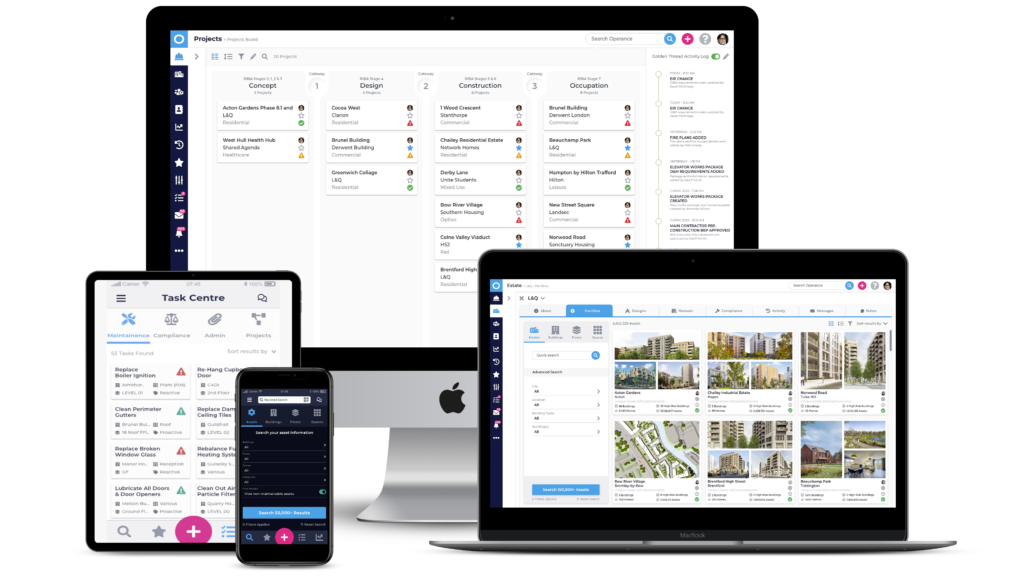
Frequently Asked Questions
A simple guide to Operations and Mainteinance (O&M) files.
What is an O&M Manual?
An Operations and Maintenance Manual, or O&M Manual, compiles all the information on the operation, maintenance, decommission and demolition of a building.
The O&M manual is basically a building user guide, like what you would get with a car. The requirement to provide an O&M manual is usually written within the project’s contractual documents and the specific contents may be listed, but can vary depending on the sector, client, contractor, operator, type of building and more. However, typical contents of an O&M manual may include:
- Project overview
- Type of construction
- As-built drawings
- Asset register
- Instructions for how to operate and maintain the facility, it components and its assets.
- Services plans
- Manufacturers instructions
- Guarantees and warranties
- Certificates e.g. fire, gas, electrical, water safety etc
- Commissioning and testing results and certificates
- Completion certificates
- Planned, preventative maintenance schedules
Are O&Ms required by law?
O&M isn’t mandatory by law, but is more often than not required by clients or their representatives to be compiled and handed over prior to practical completion.
What's the difference between an O&M file and the Health and Safety file?
Whilst the O&M isn’t mandatory by law, the health and safety file, or H&S file, is a document legally required under the Construction (Design & Management) Regulations (also known as CDM).
The H&S file is focused on providing the client with the information needed for future use, maintenance, cleaning of the building, and any future projects, with a specific and sole focus on health and safety. It should confirm what is safe, and what hazards could not be designed out, that owners, operators and occupiers should be aware of. These two documents should serve two different purposes:
- O&M: If you need to know how to do something, or when to do it, you would look in the O&M manual.
- H&S: If you need to know if something is safe to do, or where hazardous materials are, you would look in the health and safety file.
Typical contents of the health and safety file include:
- Project description
- Project directory
- Residual risks e.g. ground conditions, asbestos, fragile materials etc
- Safe working loads and structural information
- Details of any hazardous materials used
- Care of Substances Hazardous to Health (COSHH)
- Health and safety information relating to Operation and Maintenance (O&M)
- Health and safety information relating to decommissioning, removal or dismantling
- Location of services e.g. hidden services
- As-built drawings
Who is responsible for providing O&M information?
Construction projects usually involve a number of designers, consultants, contractors, suppliers and manufacturers. Each team member usually has some input into what, where, when, why and how buildings, materials and their assets are designed, specified, constructed, tested and handed over.
As such, O&M information is usually provided by most of the team, particularly on larger schemes, therefore, it is anyone that has been specifically requested within their appointment contracts to provide information that are responsible.
Who is responsible for coordinating and checking O&M information?
The party ultimately responsible for requesting, coordinating, auditing and providing the O&M manual is (if an O&M is indeed required) usually named in the project contractual documents. This party is usually named as the principal contractor (also referred to as the main contractor). However, the Principal (or Lead) Designer or even the client’s Project Manager may even be nominated.
In either case, the principal contractual wording will normally be spent down the supply chain with the responsibility to provide the information required by the relevant parties, such as external door information provided by the external door subcontractor.
When should you begin compiling O&M information?
Its good practice to begin collating and validating O&M information as soon as a project commences. Historically, O&M’s are often left until the last minute, meaning information is pulled together in a rush with little time left to audit accuracy. Therefore, arguably, the best quality O&M manuals are those that are curated from the start and have been clearly defined by the client and their asset managers, facilities management teams, operators and if required, tenants.
What's the problem with traditional O&Ms?
Where do we begin!?
Let’s break it down into sections;
- Requirements: Client O&M requirements can often be subject to ‘copy and paste’ methods, meaning wording can be taken from old, defunct documents or worse, from completeley unrelated documents taken from other schemes. Generic contractual wordings, whilst a time saver in the interim, can result in outdated, incorrect and irrelevant requirements to the particular sector, client and/or project.
- Coordination: It is very rare that a client or their named O&M provider will ever state that the information should begin collating from the start of the project, it therefore inevitably gets left until the soft landing phase or later still, the actual handover phase of a project. In either case, the task of coordinating the information, on larger schemes, is usually managed by an experienced Document Controller or specific O&M Coordinator. On smaller schemes, or even medium to large schemes delivered by smaller teams, the task can often be left to technical assistants and admin-type staff.
- Handover: it is not unrealistic that an official ‘handover’ never actually occurs, with information simply left in place as the new facility is completed, awaiting end-users to find it. Ideally, the information will be defined with help from end-users before the project even commences, then they will be given access to this developing information throughout the project in order to become familiar with their future facility before it becomes live. However, the usual scenario is that files are provided on or around the day of handover with an hour or so ‘training’ by the coordinator who describes the information available to them and where/how to find it. Whilst this is an improvement on no ‘training’ at all, advice on how to utilise the information for asset or facilities management use is usually not provided and in any case, it provides very little opportunity for the end-user to familiarisation and to query the quality of the information provided.
- Quality: Whichever person has been made responsible for collecting the O&M information, they are, traditionally, by default, the person also left to check the validity of the information provided. However, these persons are often not experienced nor qualified to identify if documents fail to reflect the buildings as-built components or as-fitted assets. As such, information can not only be inaccurate but there is the very real chance that no one will know until the information is required beyond handover.
- Formats: Traditional O&M’s are historically provided in numerous paper-filled ring binders and are now commonly supplemented alongside a ‘digital;’ representation of this same information in PDF format, handed over via disc, memory stick or online file transfer. It is also not uncommon for clients to now ask for this digital information to be provided via a Common Data Environment (CDE), alongside the provision of Building Information Modelling (BIM) models and Construction Operations Building Information Exchange (COBie) data. On rare occasions, the O&M information may be requested via raw data fields on online platforms, such as Operance. Believe it or not, it is not uncommon for all the above to be provided upon handover. Whichever format is provided, we believe at Operance that no matter if you are requesting or providing data, designs, documents and/or models, the end-user should be able to easily search, share, edit, update and utilise the information in one propriety format.
- Usability: Unless O&M information is provided in raw data format, utilising the information for asset and facilities management purposes can be a laborious and costly exercise. Paper and PDF-based information has to be manually typed up into computer-aided facilities management (CAFM) systems for instance, which can take weeks of inputting and clarifying information provided. Better, but sometimes just as frustrating, can be the use of third-party applications or consultants to upload more modern digital BIM and COBie data formats and import it into the same CAFM platforms. Either way, the original information that has now been uploaded into CAFM solutions is now simply out of date as the newer ‘uploaded or adopted’ information now becomes ‘live’ as part of the asset and facilities management process. This means that you now have two sets of information; the ‘as-built’ information and the ‘as-maintained’ information. Neither set will ever match each other and not all the original as-built information will ever be imported, meaning it has to remain, thus causing confusion and disparity between data sets. Then you have the BIM models and COBie data sheets to take into account, another data set that is neither reflective of the original paper/pdf or new ‘as-maintained’ data set. Inevitably, the newer, more modern BIM and COBie data still experience the same fate as the traditional ring binder O&Ms, they simply get stored and forgotten about, which, when it comes to redesigning, refurbishing, extending or rebuilding your facilities, results in even more issues and inefficiencies they were designed to prevent.
- Value: As you can probably gather by now, if you haven’t already experienced it firsthand, O&M information can be of very poor value. Clients are more often than not, unaware of the value quality, accurate and accessible O&M information can be for their in-use activities in order to create safer, more efficient facilities. It is normally only clients within established large estates that have developed well-defined, structured and uniform requirements with seamless information adoption techniques that manage to keep one set of data that is regularly maintained, that are ahead of the curve, but they are still very few and far between. It is up to client representatives, consultants, principal designers, contractors and the sector in general to help educate clients in best practice.
What is COBie and will it replace O&M information?
Construction Operations Building Information Exchange (COBie) is an international standard relating to managed asset information including space and equipment. It is closely associated with building information modelling (BIM) approaches to design, construction, and management of built assets.
COBie is captured and recorded in digital format, normally by way of Excel spreadsheets, but could also take form in STEP-Part 21 (also called IFC file format), and ifcXML. COBie is important project data at the point of origin, including equipment lists, product data sheets, warranties, spare parts lists, and preventive maintenance schedules. This information is essential to support operations, maintenance and asset management once the built asset is in service.
However, COBie is about building equipment only and therefore is seen as a supplement to O&M information rather than an O&M replacement as O&M information also requires copies of separate documentation such as guarentees, warranties and certificates as well as designs, project directories and much more. Whilst this is technically possible to provide, by way of hyperlinks within non-graphical COBie datasheets to separate filing systems, or, within 3D graphical BIM models, the process is unwieldy to create and can easily result in broken hyperlinks as documents are edited, moved or deleted. Whatsmore, the process of accessing, searching, editing, updating and utilising the information can be extremely complicated in the eyes if every day building owners, operatives and occupiers.
What is the 'golden thread' and will it replace O&M information?
The ‘golden thread‘ is the information that allows you to understand a building and the steps needed to keep both the building and people safe, now and in the future. Responsibility for the golden thread of information during its early development and handover falls to the nominated ‘Dutyholder’ prior to handover. The responsibility for the continued development and maintenance of the information converts to the ‘Accountable Person’ during the Occupation phase right up to until its final demolition.
Information relates specifically to those responsible for the building that are required to identify, understand, manage and mitigate building safety risks in order to prevent or reduce the severity of the consequences of fire spread, or structural collapse throughout the lifecycle of the building. It is therefore building, structural and fire safety-related information, whereas O&M is more specific to the operations and maintenance of facilities.
Like COBie and the health and safety file, there are inevitably areas of duplication and overlap and as such highlights the need for a central, open-format building information platform like Operance to define, curate, audit and maintain all building information in one central place, and using smart raw data tagging techniques, will enable information to be provided once and segregate information into separate O&M, H&S and Fire and Emergency File formats.
Here’s the full definition of the golden thread as provided by the Building Regulations Advisory Committee (BRAC):
- The golden thread will hold the information that those responsible for the building require to identify, understand, manage and mitigate building safety risks in order to prevent or reduce the severity of the consequences of fire spread, or structural collapse throughout the lifecycle of the building. The information stored in the golden thread will be reviewed and managed so that the information retained at all times achieves this purpose.
- The golden thread covers both the information and documents, and the information management processes (or steps) used to support building safety. The government has defined the information as including all the information necessary to understand and manage risks to prevent or reduce the severity of the consequences of fire spread, or structural collapse in a building.
- The golden thread information should be stored as structured digital information. It will be stored, managed, maintained and retained in line with the golden thread principles (see annex below). The government will specify digital standards, which will provide guidance on how the principles can be met.
- The digital thread information management approach will apply through design construction, occupation, refurbishment and on-going management of buildings. It supports the wider changes in the regime to promote a culture of building safety.
- Building safety should be taken to include the fire and structural safety of a building and the safety of all the people in or in the vicinity of a building, (including emergency responders).

Up to 30% discount with Enterprise Edition
Get up to 30% discount when your projects total £50 million or more, providing considerable savings. Contact sales for a bespoke quotation for your business.




